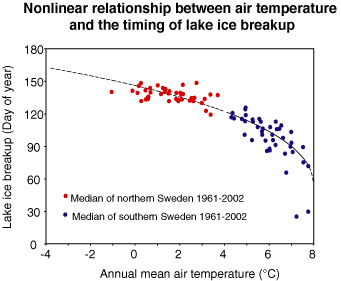 |
||
|
Temperature associated effects on physical lake processes |
||
|
A typical physical lake process is the timing of lake ice breakup. It has been of interest for centuries because of its importance for transportation and fishing. It is of critical ecological importance for lakes because the disappearance of the ice cover has a drastic effect on the underwater light climate, nutrient recycling and oxygen conditions, influencing for instance the production and biodiversity of phytoplankton and the occurence of winter fishkills. Air temperature is the key variable determining the timing of ice breakup. Consequently, the warmer the winters are the earlier is the breakup of ice. Analyzing historical trends in lake and river ice cover in the Northern Hemisphere reveals that an air temperature increase of about 1.2°C during the past 100 years has caused an on average 6.3 days earlier ice breakup in the Northern Hemisphere1. The trends towards earlier ice breakup as a response to warmer air temperatures are however not equally pronounced in the Northern Hemisphere. In the relatively warm southern part of Sweden an annual mean air temperature increase of 1°C causes an about 14 days earlier ice breakup (it can be up to 35 days earlier in the most southern part of Sweden) while the same air temperature increase causes an only 4 days earlier ice breakup in the relatively cold northern part of Sweden2. The reason for this behaviour is a nonlinear relationship between air temperature and the timing of lake ice breakup (see figure). During the IPCC reference period 1961-90, lakes in southern Sweden experienced on average a one month earlier ice breakup. The rate of change during the 30 year period steadily decreased towards the north of Sweden3 (see figure).
|
1 Magnuson, J. J., Robertson, D. M., Benson, B. J., Wynne, R. H., Livingstone, D. M. et al. 2000. Historical trends in lake and river ice cover in the Northern Hemisphere. Science 289: 1743-1746. 2 Weyhenmeyer, G. A., Meili, M. and Livingstone, D. M. 2004. Nonlinear temperature response of lake ice breakup. Geophysical Research Letters 31, L07203, doi: 10.1029/2004GL019530. 3 Weyhenmeyer, G. A., Meili, M. and Livingstone, D. M. 2005. Systematic differences in the trend towards earlier ice-out on Swedish lakes long a latitudinal temperature gradient. Verh. Internat. Verein. Limnol. 29: 257-260. Further reading: Eklund, A. 1999. Isläggning and islossning i svenska sjöar (in Swedish). SMHI-report Hydrologi 81, 24 pp. Livingstone, D. M. 1997. Break-up dates of alpine lakes as proxy data for local and regional mean surface air temperatures. Climatic Change 37: 407-439. Livingstone, D. M. 1999. Ice break-up on southern Lake Baikal and its relationship to local and regional air temperatures in Siberia and to the North Atlantic Oscillation. Limnol. Oceanogr. 44: 1486-1497. Magnusson, J. J., Wynne, R. H., Benson, B. J. and Robertson, D. M. 2000. Lake and river ice as powerful indicator of past and present climate. Verh. Internat. Verein. Limnol. 27: 2749-2820. Palecki, M. A. and Barry, R. G. 1986. Freeze-up and break-up of lakes as an index of temperature changes during the transition seasons: a case study for Finland. Journal of Climate and Applied Meteorology: 25: 893-902. Todd, M. C. and Mackay, A. W. 2003. Large-scale climatic controls on Lake Baikal ice cover. Journal of Climate 16: 3186-3199. |
|

